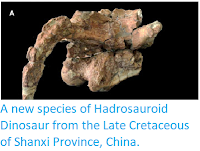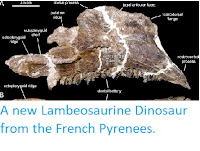Hadrosaurs, or Duck-Billed Dinosaurs, were large herbivorous
Ornithischian Dinosaurs widespread across Laurasia (Eurasia plus North
America; Laurasia split away from the southern continents in the
Triassic, the split into North America and Eurasia during the
Cretaceous) as well as South America and Antarctica during the Late Cretaceous. They were descended from the
earlier Iguanadontids, but with more sophisticated jaws and teeth, which
allowed them to chew their food, not by side-to-side motion as in a
modern mammal, but by a unique flexion of the upper jaw parts, which
moved apart as the lower jaw moved upwards (from which scientists
conclude these Dinosaurs must have had lips, unlike any modern relative
of the Dinosaurs). The term 'Hadrosauroid' refers to the widest possible
grouping of Hadrosaurs, including all animals in the group after their
evolutionary split with the Iguanadontids in the Early Cretaceous,
whereas the most derived members of the group are split into two
subgroups, the Lambeosaurs, which had hollow bony crests, thought to
have been used for making sounds, and the Saurolophides, or Hadrosaurines, which either
lacked crests or had solid ones.
In a paper published in the journal Scientific Reports on 5 September 2019, Yoshitsugu Kobayashi of the Hokkaido University Museum, Tomohiro Nishimura of the Hobetsu Museum, Ryuji Takasaki of the Department of Natural History and Planetary Sciences at Hokkaido University, Kentaro Chiba of the Faculty of Biosphere-Geosphere Science at the Okayama University of Science, Anthony Fiorillo of the Perot Museum of Nature and Science, Kohei Tanaka of the Graduate School of Life and Environmental Sciences at rhe University of Tsukuba, Tsogtbaatar Chinzorig of the Division of Vertebrate Paleontology at the Institute of Paleontology and Geology of the Mongolian Academy of Sciences, Tamaki Sato of the Department of Astronomy and Earth Sciences at Tokyo Gakugei University, and Kazuhiko Sakurai, also of the Hobetsu Museum, describe a new species of Hadrosaur from the Late Cretaceous Hakobuchi Formation of Hokkaido, Japan.
The Hakobuchi Formation is the uppermost unit of the Yezo Group, which is a part of a Cretaceous to Paleocene forearc basin deposit that outcrops in southern Hokkaido, Japan. The formation consists of alternating layers of fine- to medium-grained sandstone with hummocky cross-stratification, a bedding pattern typically associated with the action of large storms (such as typhoons) below the fair weather wave base, and sandy mudstones lacking cross-stratification and containing glauconite, a mineral considered indicative of outer shelf environments with low sedimentation rates. The unit of the formation which produced the specimen from which the new species is described has been correlated to the lowest Maastrichtian in age, making it about 72 million years old.
The new Hadrosaur species is named Kamuysaurus japonicus, where 'Kamuysaurus' derives from 'Kamuy', a spiritual or divine being in the mythology of the indigenous Ainu people of Hokkaido, plus '-saurus', the Latin term for a Lizard or Reptile, frequently used as a suffix for Dinosaur names, and 'japonicus' indicates that it comes from Japan. The species is described from a single specimen comprising a nearly complete skeleton with the skull and mandible, derived from an outcrop of the Hakobuchi Formation which is considered to represent an outer shelf environment because of the presence of glauconite sandstone and the absence of hummocky cross-stratification. Despite its completeness, some bones are heavily damaged or eroded by a bio-erosion prior to burial.
The specimen is assigned as a Hadrosaurine Hadrosaurid with the following unique characters: the midpoint of the quadratojugal notch is positioned at roughly three-quarters of the total length of the quadrate (a bone in the jaw which forms part of the inner ear in Mammals) from the dorsal end, the ascending process of the surangular (bone in the jaw which has been lost in Mammals) is short, and the neural spines of sixth to thirteenth dorsal vertebrae are inclibed forwards. Kamuysaurus japonicus also has a slightly curved primary ridge on the maxillary(upper) teeth, the high average height/width ratio of the dentary (lower) teeth is over 3.30, there is a moderate medial extension of the symphyseal process of the dentary (jawbone), the anterior margin of the coronoid process of the dentary is more developed than the posterior margin, the triangular ventral margin of the anterior process of the jugal as wide as it is high, the palatine articular facet of the jugal (cheekbone) is moderately inclined, the caudal margin of the quadratojugal flange of the jugal is nearly straight, theanterodorsal margin of the prefrontal (bone that forms the upper inside portion of the orbit) along the orbital rim is smoothly curved, sthe quamosal process of the postorbital (bone that forms the upper outside portion of the orbit) terminates anterior to the quadrate cotylus, the nasofrontal sutural surface of the frontal (connection between the frontal bone, which makes up the forhead, and the bones of the snout) is long, the infratemporal fenestra (opening in the skull behind the eye) is subrectangular, there is a weak expansion of deltopectoral crest of the humerus (long bone in the upper arm), the humerus is slender with the humeral shaft being less than 20% as wide as it is long.
In order to access the somatic maturity of this individual, the right tibia was thin-sectioned. Tibiae have been often used for osteohistological examination of Hadrosaurs, because they have a thick cortex and therefore preserve a more complete record of the growth. This ontogenetic assessment indicated that this individual had reached its somatic maturity. Reconstruction of the specimen as a quadruped gave an estimated body mass of 5296 kg, while reconstruction as a biped gave a mass of 4087 kg; in both reconstructions the body length is about 8 m and no further significant growth could have been expected if the animal had continued living.
See also...
The new Hadrosaur species is named Kamuysaurus japonicus, where 'Kamuysaurus' derives from 'Kamuy', a spiritual or divine being in the mythology of the indigenous Ainu people of Hokkaido, plus '-saurus', the Latin term for a Lizard or Reptile, frequently used as a suffix for Dinosaur names, and 'japonicus' indicates that it comes from Japan. The species is described from a single specimen comprising a nearly complete skeleton with the skull and mandible, derived from an outcrop of the Hakobuchi Formation which is considered to represent an outer shelf environment because of the presence of glauconite sandstone and the absence of hummocky cross-stratification. Despite its completeness, some bones are heavily damaged or eroded by a bio-erosion prior to burial.
(a) The holotype skeleton of Kamuysaurus japonicus. (b) Reconstructed skeleton, showing recovered elements. Selected postcranial elements: cervical vertebrae (atlas, axis, and fourth and twelfth cervicals) in left lateral view (c), dorsal vertebrae (first, seventh, and sixteenth dorsals) in left lateral view (d), caudal vertebrae (anterior, middle, and posterior caudals) in left lateral view (e), left scapula (f) and coracoid (g) in lateral view, right sternum in ventral view (h), left humerus in anterior view (i), right ulna and radius in medial view (j), right manus in dorsal view (k), right pelvis in lateral view (l), right femur in anterior view (m), right tibia in anterior view (n), right fibula in lateral view (o), right astragalus and calcaneum, articulated positioned with tibia (p), and right pes in dorsal view (q). All scales are 10 cm except 1 m scale for (b). Abbreviations; ac, acromion process; ast, astragalus; cal, calcaneum; dpc, deltopectoral crest; fi, fibula; icg, intercondylar groove; il, ilium; is, ischium; ltr, lesser trochanter; mc2, metacarpal II; mc5, metacarpal V; mt2, metatarsal II; mt4, metatarsal IV; nc, neurocentrum; od, odontoid; olp, olecranon process; pc, pleurocentrum; pu, pubis; ra, radius; ti, tibia; ul, ulna; vp, ventral process. Kobayashi et al. (2019).
The specimen is assigned as a Hadrosaurine Hadrosaurid with the following unique characters: the midpoint of the quadratojugal notch is positioned at roughly three-quarters of the total length of the quadrate (a bone in the jaw which forms part of the inner ear in Mammals) from the dorsal end, the ascending process of the surangular (bone in the jaw which has been lost in Mammals) is short, and the neural spines of sixth to thirteenth dorsal vertebrae are inclibed forwards. Kamuysaurus japonicus also has a slightly curved primary ridge on the maxillary(upper) teeth, the high average height/width ratio of the dentary (lower) teeth is over 3.30, there is a moderate medial extension of the symphyseal process of the dentary (jawbone), the anterior margin of the coronoid process of the dentary is more developed than the posterior margin, the triangular ventral margin of the anterior process of the jugal as wide as it is high, the palatine articular facet of the jugal (cheekbone) is moderately inclined, the caudal margin of the quadratojugal flange of the jugal is nearly straight, theanterodorsal margin of the prefrontal (bone that forms the upper inside portion of the orbit) along the orbital rim is smoothly curved, sthe quamosal process of the postorbital (bone that forms the upper outside portion of the orbit) terminates anterior to the quadrate cotylus, the nasofrontal sutural surface of the frontal (connection between the frontal bone, which makes up the forhead, and the bones of the snout) is long, the infratemporal fenestra (opening in the skull behind the eye) is subrectangular, there is a weak expansion of deltopectoral crest of the humerus (long bone in the upper arm), the humerus is slender with the humeral shaft being less than 20% as wide as it is long.
Life reconstruction of Kamuysaurus japonicus with a carcass of a Mosasaur, Phosphorosaurus ponpetelegans, a Sea Turtle, Mesodermochelys undulates, and shells of Ammonoids, Patagiosites compressus and Gaudryceras hobetsense, and Bivalves, Nannonavis elongatus on the beach. The individual of Kamuysaurus in the foreground is reconstructed based on the assumption of the presence of a supracranial crest, similar to a sub-adult form of Brachylophosaurus. The individual behind it is reconstructed without the crest. Kobayash et al. (2019).
In order to access the somatic maturity of this individual, the right tibia was thin-sectioned. Tibiae have been often used for osteohistological examination of Hadrosaurs, because they have a thick cortex and therefore preserve a more complete record of the growth. This ontogenetic assessment indicated that this individual had reached its somatic maturity. Reconstruction of the specimen as a quadruped gave an estimated body mass of 5296 kg, while reconstruction as a biped gave a mass of 4087 kg; in both reconstructions the body length is about 8 m and no further significant growth could have been expected if the animal had continued living.
Carcass of Kamuysaurus, floating in the sea, with two Mosasaurs, Mosasaurus hobetsuensis, two Sea Turtles, Mesodermochelys undulates, and four Ammonoids, Pachydiscus japonicus. Kobayashi et al. (2019).
See also...
Follow
Sciency Thoughts on Facebook.









